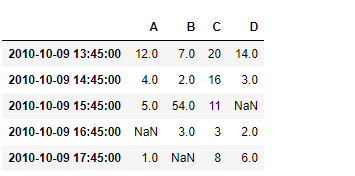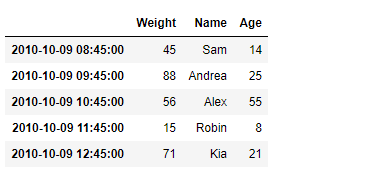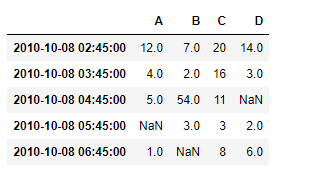Python| Pandas DataFrame.tshift
Pandas DataFrame 是一种二维大小可变的、潜在异构的表格数据结构,带有标记的轴(行和列)。算术运算在行标签和列标签上对齐。它可以被认为是 Series 对象的类 dict 容器。这是 Pandas 的主要数据结构。
Pandas DataFrame.tshift()函数用于移动时间索引,如果在给定数据帧中可用,则使用索引的频率。
Syntax: DataFrame.tshift(periods=1, freq=None, axis=0)
Parameter :
periods : Number of periods to move, can be positive or negative
freq : Increment to use from the tseries module or time rule (e.g. ‘EOM’)
axis : Corresponds to the axis that contains the Index
Returns : shifted : NDFrame
示例 #1:使用DataFrame.tshift()函数将给定数据帧的基于日期时间的索引移动 5 小时。
# importing pandas as pd
import pandas as pd
# Creating the DataFrame
df = pd.DataFrame({'Weight':[45, 88, 56, 15, 71],
'Name':['Sam', 'Andrea', 'Alex', 'Robin', 'Kia'],
'Age':[14, 25, 55, 8, 21]})
# Create the index
index_ = pd.date_range('2010-10-09 08:45', periods = 5, freq ='H')
# Set the index
df.index = index_
# Print the DataFrame
print(df)
输出 :

现在我们将使用DataFrame.tshift()函数将给定数据帧的基于日期时间的索引移动 5 小时。我们将“5H”作为频率值传递给函数。
# Shift by 5 hours
result = df.tshift(freq = '5H')
# Print the result
print(result)
输出 :

正如我们在输出中看到的那样, DataFrame.tshift()函数已成功地将给定数据帧的基于日期时间的索引移动了指定的频率。示例 #2:使用DataFrame.tshift()函数将给定数据帧的基于日期时间的索引移动 -30 个句点。
# importing pandas as pd
import pandas as pd
# Creating the DataFrame
df = pd.DataFrame({'Weight':[45, 88, 56, 15, 71],
'Name':['Sam', 'Andrea', 'Alex', 'Robin', 'Kia'],
'Age':[14, 25, 55, 8, 21]})
# Create the index
index_ = pd.date_range('2010-10-09 08:45', periods = 5, freq ='H')
# Set the index
df.index = index_
# Print the DataFrame
print(df)
输出 :

现在我们将使用DataFrame.tshift()函数将给定数据帧的基于日期时间的索引移动 -30 个周期。这将使指数在过去的同一频率上移动 30 个周期。
# Shift by -30 periods
result = df.tshift(periods = -30)
# Print the result
print(result)
输出 :

正如我们在输出中看到的, DataFrame.tshift()函数已成功地将给定数据帧的基于日期时间的索引移动了指定的周期。